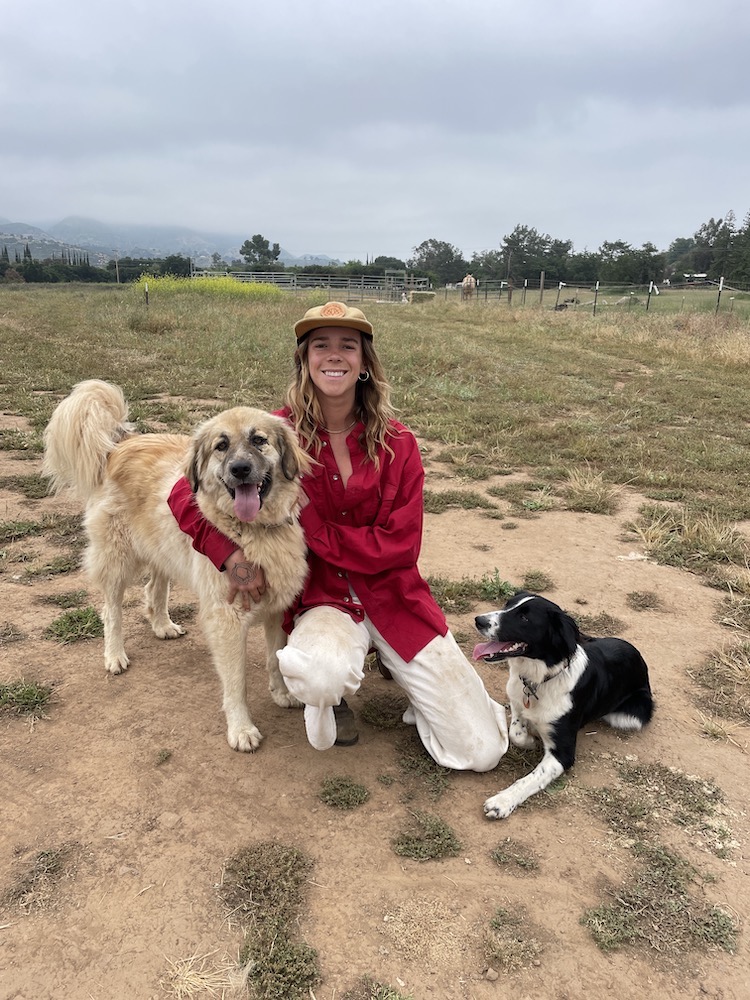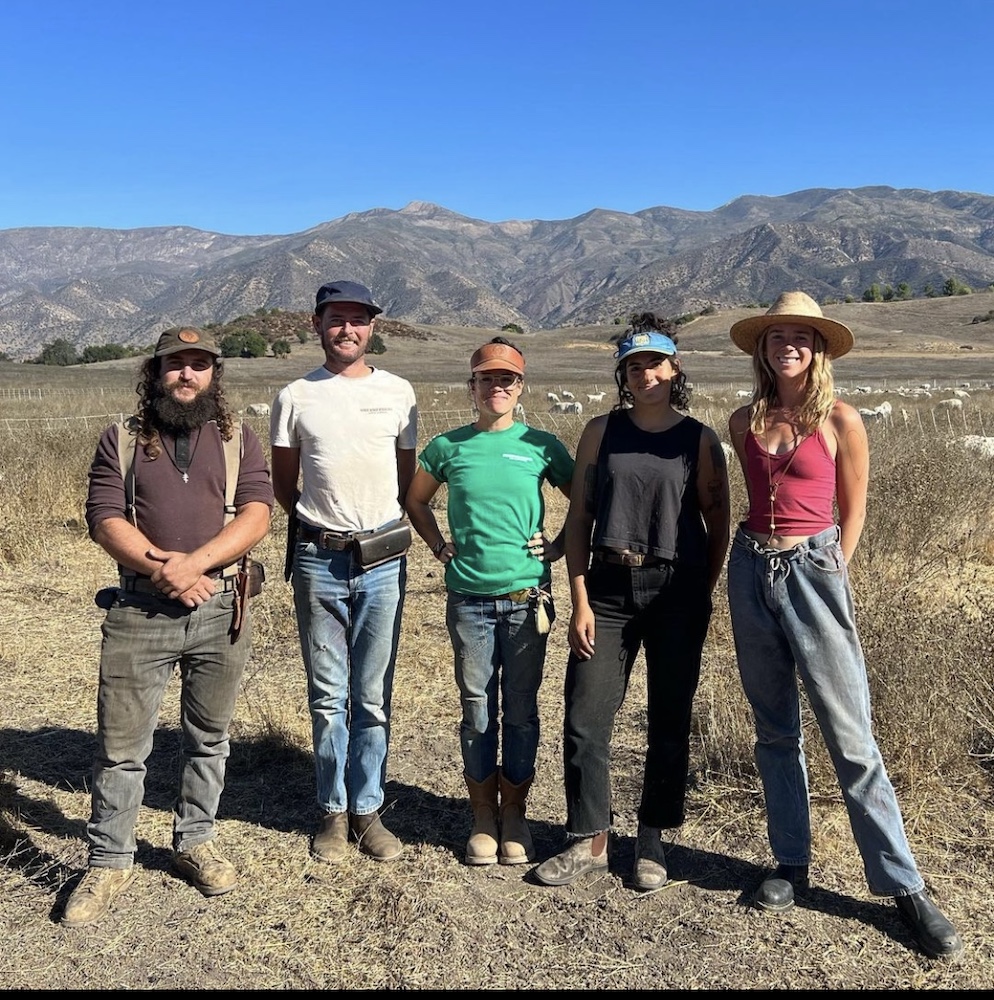Regan Williams: Shepherdess in Training

Deep in the Ojai Valley hills sits Shepherdess Land & Livestock Co., along with their youngest recruit, Crane School alumna Regan Williams. Regan had a long-standing interest in farming and working with animals, recently picking up classes in holistic land management. But it wasn’t until Regan met her new boss Cole Bush, founder of Shepherdess Land & Livestock, that she learned about a future in shepherding.
“I never thought of it as a potential job. It just seemed like an ancient, beautiful practice. Not something that was part of the modern world,” says Regan.
Regan and I were thinking along the same lines. Having never spoken to a shepherd before, my image of one was somewhat biblical – maybe something from the Homeric poems we discussed in English class. In fact, shepherding as a profession is alive and well today, and it sits closer to home than you may think.
Shepherdess Land & Livestock operates out of Ojai as a contract grazer. That means they bring the sheep to different locations, so they can help facilitate ecological restoration, something that is increasingly important as climate conditions deteriorate.
“Part of the reason we perform these contract grazings is for fire mitigation – to reduce the intensity of wildfires and protect communities,” says Regan. “Another big reason is that by grazing, we restore the landscape and make it more resilient.”
As we know, a prominent concern following recent weather events is that during a storm, the soil becomes saturated too quickly. The hardened earth and superficial roots systems are not prepared to absorb rainfall. This makes a dry environment even drier in the long-term. By performing contract grazings, the sheep prune shrubbery that pose a fire risk; they fertilize the ground, and their hooves till the soil, making it a softer, more hospitable environment.
But a key principle of shepherding is understanding that each species has their niche within the environment. Shepherds leverage this knowledge by deploying different animals for different jobs. For instance, at Shepherdess Land & Livestock they use sheep as grazers and goats as browsers because these animal types target different plants to eat. Some shepherds use cows, water buffalo, and even ducks to restore and treat the environment in the most appropriate way.

Of course, shepherds have their own role within the ecosystem: stewarding healthy growth and change. Few know this as well as Regan, who was initiated into shepherding during Shepherdess Land & Livestock’s first lambing season.
“It was definitely the hardest thing I have ever done. You don’t sleep really during lambing season, and we were pasture lambing so we were doing it during the height of the storms and the rain.”
In total, Regan helped birth about 275 lambs between October and December of this year. By the time Christmas rolled around, it was time for a much-deserved break.
“I witnessed a lot of birth and a lot of death too in the course of that. It was really shocking, and at the same time it was so beautiful,” Regan says. “Having bonfires, seeing all the other shepherds at night, having those moments to reflect became the most fulfilling to me.”
Regan emphasizes the idea of seeing life’s entire cycle; so much of a shepherd’s work is about taking care of beginnings and endings. As a new year began, Regan had her own beginning to take care of. It was now time for her to start training her young herding puppy Bobo.

A shepherd builds a special one-on-one relationship with their dog over the course of many years.
“They’re our coworkers, our best friends, and they need to be because they’re with us all the time,” says Regan. “The dogs are my favorite part of the work honestly. They’re the biggest headache and the most expensive thing, but they’re so fun.”
Of course, Regan reminded me that training herding dogs isn’t just about the fun. There is a lot of etiquette surrounding the herding dogs and their role on the ranch. For example, it is a serious faux pas to give commands to another shepherd’s dog. It is also important that training does not officially start until the dog is about two years old, when they are mature enough to handle the work. Naturally, learning to give commands is just as much work for the shepherd as it is for the dog. But if you think that learning herding dog commands is the only new language shepherds need in their arsenal, you would be mistaken.
In our conversation, Regan introduced me to a practice known as “low stress stockmanship.” This is an ideology that emphasizes harmony when working with livestock. One of the ways they do this at Shepherdess Land & Livestock is by communicating with the animals in a way that they will understand.
“In some practices they use electric rods or they’re yelling or hitting, but this really stresses the sheep out and scares them. Instead, we try to work with the animals in the most peaceful way possible. For example, if you want a sheep to go forward, you walk straight up to them and they’ll go forwards. It’s like learning to dance. And when we’re guiding them into the trailers instead of yelling, we make these little grunting noises instead. It’s our way of saying, ‘Move over there, please.’”
While so much of a shepherd’s responsibilities are focused on nurturing growth in the environment around them, they also have an essential duty to themselves. A new shepherdess must dedicate a lot of time to personal growth in order to do the job.
“When you’re out on the ranch, there’s always a lot on the line. The people who do this are incredibly competent and very smart. People aren’t aware of just how technical the work is. I’m learning how to hitch a trailer, how to haul water, how to build an electric fence. And at the same time, I’m learning how to hold my body when I’m doing it, so I don’t hurt myself. I’m learning how to take care of myself so I can come back again and do it the next day.”
But as Regan said, growth isn’t just about learning but also about getting the chance to reflect, seeing and appreciating the big picture.
“I have never felt more fulfilled. I knew that, even when I was having a really hard day, the impact I was having was good. What I had done would benefit something bigger than me.”







You must be logged in to post a comment.